Abstract
Prostaglandins (PGs) protect gastric mucosa against damage produced by acetylsalicylic acid (ASA). Whether this effect of prostaglandins is truly cytoprotective and whether cAMP plays an important role in this effect is uncertain. We studied the effect of: (1) 16,16 dimethyl prostaglandin E2 (dmPGE2), isobutylmethyl xanthine (IMX), and dibutyryl cAMP (DBcAMP) on ASA-induced damage to monolayer cultures of rat gastric mucosa composed primarily of mucus cells; (2) dmPGE2 on ASA absorption into the cultured cells. Cell damage was quantitated by 51Cr-release and trypan blue staining. Ten millimoles ASA significantly increased 51Cr-release (indicating cell damage) at pH 5.0, but not at pH 7.4. DmPGE2 significantly reduced ASA-induced increase of 51Cr-release. Isobutylmethyl xanthine did not change the rate of 51Cr-release caused by ASA plus dmPGE2. Dibutyryl cAMP did not significantly alter 51Cr-release caused by ASA. A dose response study of ASA damage showed close correlation between 51Cr-release and trypan blue staining (r = 0.93). Dimethyl prostaglandin E2 did not affect 14C-ASA incorporation by the cells at either pH 7.4 or pH 5.0. We conclude that: (1) dmPGE2 exerts a cytoprotective effect on cultured rat gastric cells; (2) cAMP does not play an important role in such cytoprotection; (3) this protection is not because of interference with ASA absorption by prostaglandin.
Full text
PDF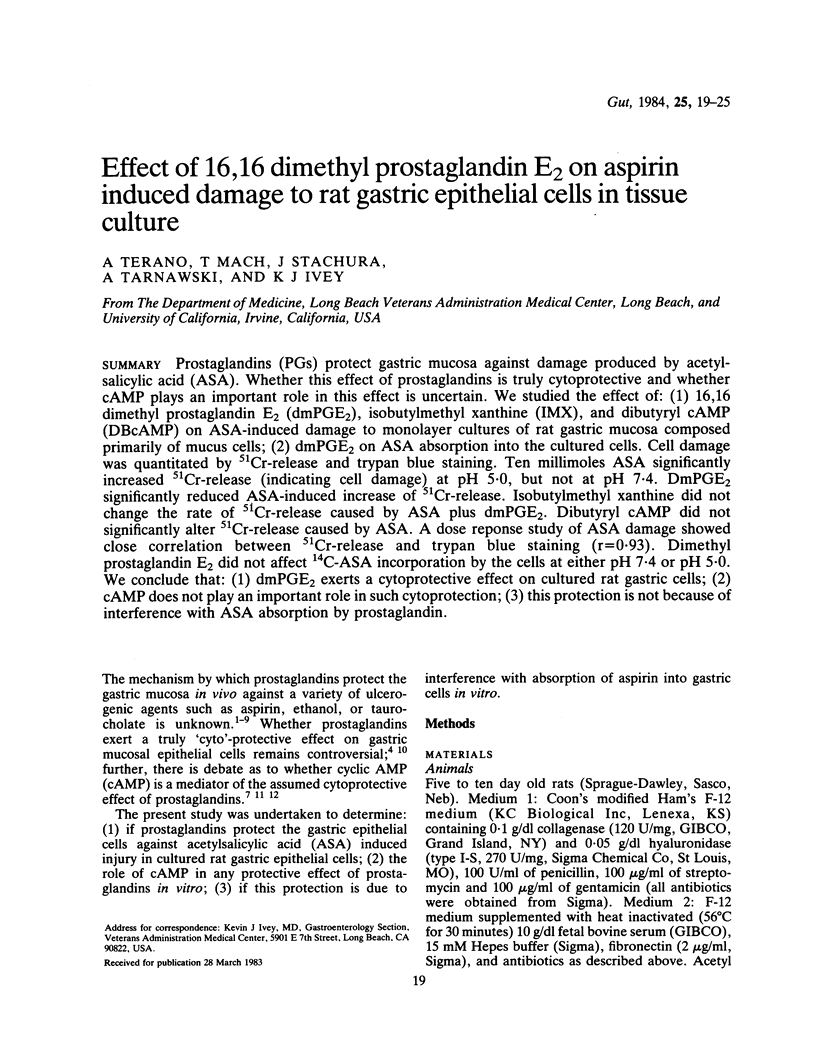
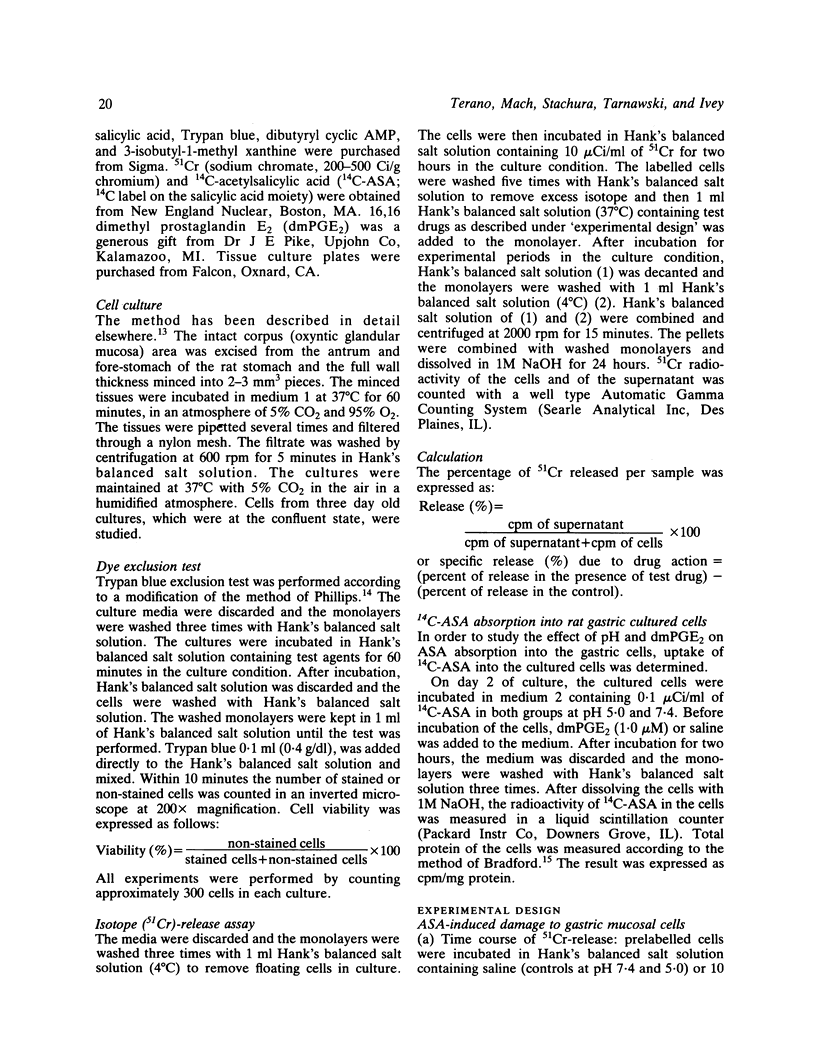
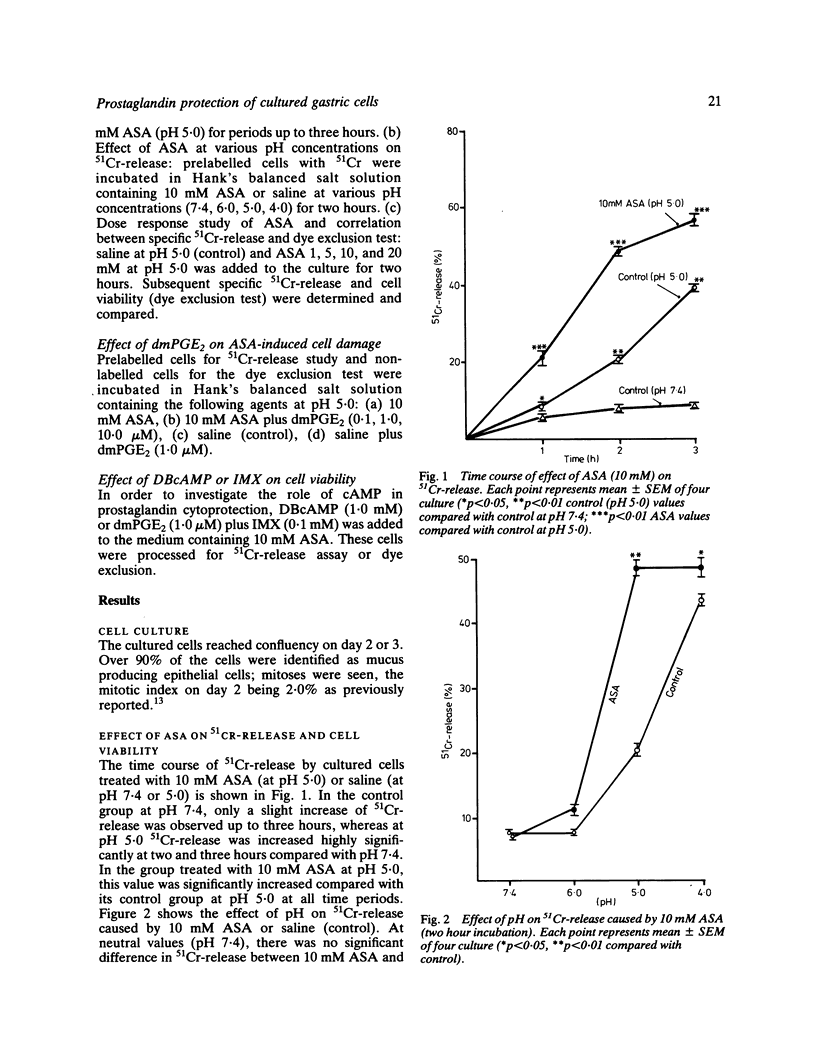
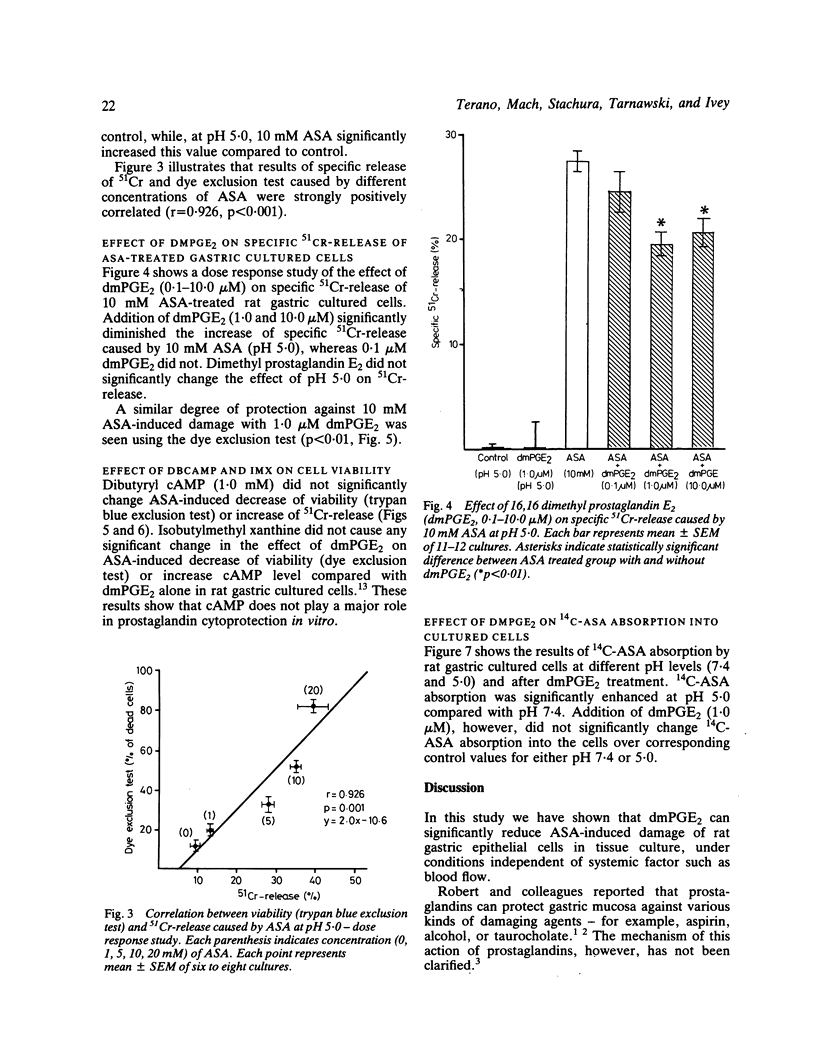
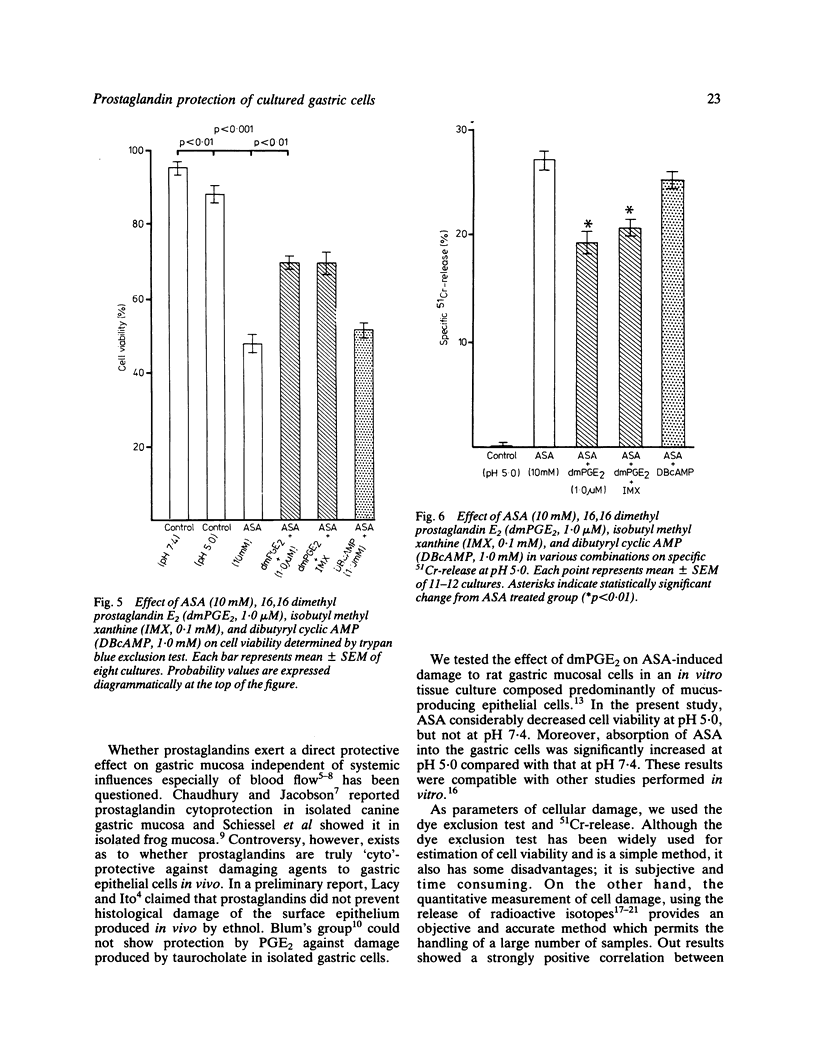
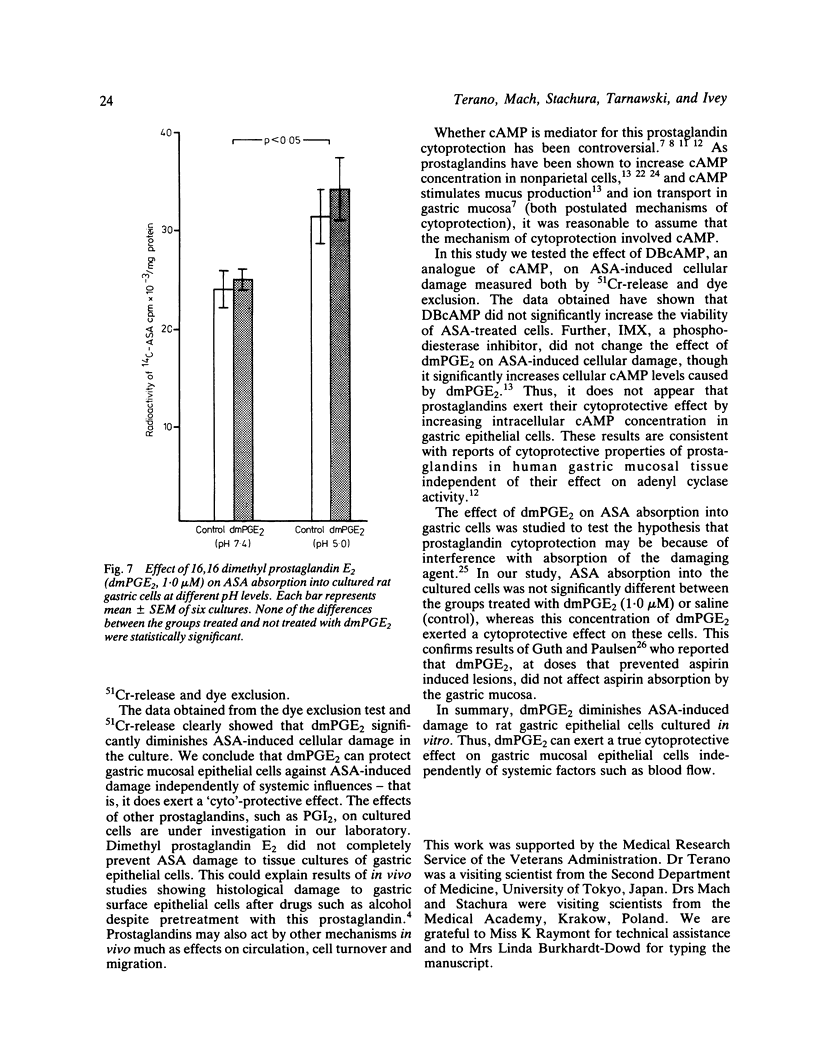

Selected References
These references are in PubMed. This may not be the complete list of references from this article.
- Barzilai A., Schiessel R., Kivilaakso E., Matthews J. B., Fleischer L. A., Bartzokis G., Silen W. Effect of 16-16-dimethyl-prostaglandin E2 on ulceration of isolated amphibian gastric mucosa. Gastroenterology. 1980 Jun;78(6):1508–1512. [PubMed] [Google Scholar]
- Bhuyan B. K., Loughman B. E., Fraser T. J., Day K. J. Comparison of different methods of determining cell viability after exposure to cytotoxic compounds. Exp Cell Res. 1976 Feb;97(2):275–280. doi: 10.1016/0014-4827(76)90617-0. [DOI] [PubMed] [Google Scholar]
- Bommelaer G., Guth P. H. Protection by histamine receptor antagonists and prostaglandin against gastric mucosal barrier disruption in the rat. Gastroenterology. 1979 Aug;77(2):303–308. [PubMed] [Google Scholar]
- Bradford M. M. A rapid and sensitive method for the quantitation of microgram quantities of protein utilizing the principle of protein-dye binding. Anal Biochem. 1976 May 7;72:248–254. doi: 10.1006/abio.1976.9999. [DOI] [PubMed] [Google Scholar]
- Chaudhury T. K., Jacobson E. D. Prostaglandin cytoprotection of gastric mucosa. Gastroenterology. 1978 Jan;74(1):58–63. [PubMed] [Google Scholar]
- Cooke A. R., Hunt J. N. Absorption of acetylsalicylic acid from unbuffered and buffered gastric contents. Am J Dig Dis. 1970 Feb;15(2):95–102. doi: 10.1007/BF02235637. [DOI] [PubMed] [Google Scholar]
- FORBES I. J. Studies of cytotoxicity using P-32. Aust J Exp Biol Med Sci. 1963 Jun;41:255–264. doi: 10.1038/icb.1963.25. [DOI] [PubMed] [Google Scholar]
- Guth P. H., Paulsen G. Prostaglandin cytoprotection does not involve interference with aspirin absorption. Proc Soc Exp Biol Med. 1979 Oct;162(1):128–130. doi: 10.3181/00379727-162-40631. [DOI] [PubMed] [Google Scholar]
- Lacy E. R., Ito S. Microscopic analysis of ethanol damage to rat gastric mucosa after treatment with a prostaglandin. Gastroenterology. 1982 Sep;83(3):619–625. [PubMed] [Google Scholar]
- Miller T. A., Jacobson E. D. Gastrointestinal cytoprotection by prostaglandins. Gut. 1979 Jan;20(1):75–87. doi: 10.1136/gut.20.1.75. [DOI] [PMC free article] [PubMed] [Google Scholar]
- Müller-Lissner S. A., Fimmel C., Sonnenberg A., Peskar B., Fischer J. A., Blum A. L. The effect of prostaglandins on isolated rat gastric cells. Scand J Gastroenterol Suppl. 1981;67:229–232. [PubMed] [Google Scholar]
- Robert A. Antisecretory, antiulcer, cytoprotective and diarrheogenic properties of prostaglandins. Adv Prostaglandin Thromboxane Res. 1976;2:507–520. [PubMed] [Google Scholar]
- Robert A., Nezamis J. E., Lancaster C., Hanchar A. J. Cytoprotection by prostaglandins in rats. Prevention of gastric necrosis produced by alcohol, HCl, NaOH, hypertonic NaCl, and thermal injury. Gastroenterology. 1979 Sep;77(3):433–443. [PubMed] [Google Scholar]
- Schiessel R., Matthews J., Barzilai A., Merhav A., Silen W. PGE2 stimulates gastric chloride transport: possible key to cytoprotection. Nature. 1980 Feb 14;283(5748):671–673. doi: 10.1038/283671a0. [DOI] [PubMed] [Google Scholar]
- Soll A. H., Whittle B. J. Interaction between prostaglandins and cyclic AMP in the gastric mucosa. Prostaglandins. 1981;21 (Suppl):39–45. doi: 10.1016/0090-6980(81)90115-5. [DOI] [PubMed] [Google Scholar]
- Terano A., Ivey K. J., Stachura J., Sekhon S., Hosojima H., McKenzie W. N., Jr, Krause W. J., Wyche J. H. Cell culture of rat gastric fundic mucosa. Gastroenterology. 1982 Dec;83(6):1280–1291. [PubMed] [Google Scholar]
- WIGZELL H. QUANTITATIVE TITRATIONS OF MOUSE H-2 ANTIBODIES USING CR-51-LABELLED TARGET CELLS. Transplantation. 1965 May;3:423–431. doi: 10.1097/00007890-196505000-00011. [DOI] [PubMed] [Google Scholar]
- Whittle B. J. Mechanisms underlying gastric mucosal damage induced by indomethacin and bile-salts, and the actions of prostaglandins. Br J Pharmacol. 1977 Jul;60(3):455–460. doi: 10.1111/j.1476-5381.1977.tb07522.x. [DOI] [PMC free article] [PubMed] [Google Scholar]
- Wollin A., Soll A. H., Samloff I. M. Actions of histamine, secretin, and PGE2 on cyclic AMP production by isolated canine fundic mucosal cells. Am J Physiol. 1979 Nov;237(5):E437–E443. doi: 10.1152/ajpendo.1979.237.5.E437. [DOI] [PubMed] [Google Scholar]


